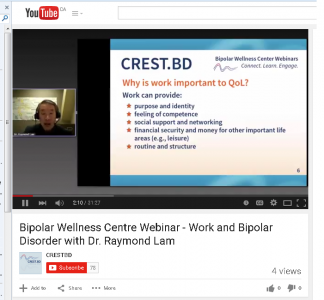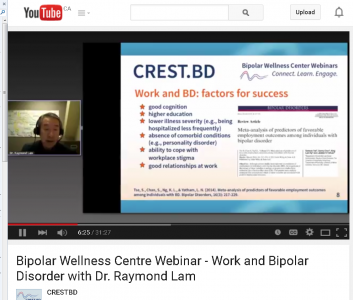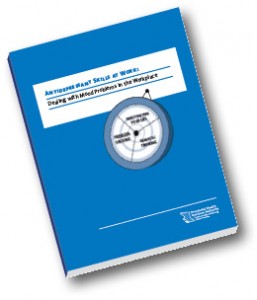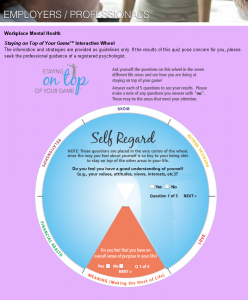Note: you are receiving weekly MoodFx Tips because you subscribed through your MoodFx account at www.MoodFx.ca. To unsubscribe to these Tips and other MoodFx alerts, such as Mood Check and Appointment reminders, simply sign in to your MoodFx account at www.MoodFx.ca and go to the Alerts page. There, you can select whether you wish to subscribe or unsubscribe to any and all notifications. If you are having difficulty, you can also email info@MoodFx.ca for assistance.
Work and Mood Disorders Webinar hosted by MoodFx Creator Dr. Raymond Lam
This week, check out this webinaar on Work and Bipolar Disorder, hosted by MoodFx creator Dr. Raymond Lam. Dr. Lam discusses the importance of work to our quality of life, and shares some ways you can take action to improve your work functioning, including:
- Optimizing your medication and therapy treatments.
- Some medication side-effects , such as fatigue and cognitive difficulties, may be more disruptive to work functioning than others. Working towards a treatment plan that minimizes these side-effects can be helpful.
- Consulting your employer’s Human Resources department to learn about resources that are available to you.
- For example, many larger employers provide free, confidential Employee Assistance Programs (EAPs) that provide counseling for work and personal issues.
- Knowing that employers have certain legal responsibilities to accommodate and support employees with medical conditions and disabilities, including mental health conditions.
- Knowing that individualized supports instead of one-size-fits-all approaches have been increasingly recognized as most helpful for people with depression and bipolar depression.
- Check out our past tips for links to resources on working with your employer to create a workplace environment that works for you.
- Exploring further resources–many excellent online resources are recommended in the webinar.
Watch here:
You can watch other webinars in this series, part of CREST.BD’s Bipolar Wellness Centre, here.
What I Wish I Knew – One woman shares her experience to help others
This week, check out Mandi Luis’ tour through what she wishes she had known when she experienced a bout of depression that affected all areas of her life, including her work. She shares information and tips that she hopes might make a difference for others dealing with depression and anxiety.
What I Wish I Knew: A Snapshot of My Experience with Mental Illness at Work, by Mandi Luis:
- I was at risk for depression
- I was ill, not weak
- Information about treatment
- Depression would impact every area of my life
- I needed help earlier
- I was not the only one that had experienced this
- I needed to be valued at work
- It was okay to ask for my manager’s help
- People at my workplace needed to listen
- I needed ongoing support at work
- I needed my benefits to cover more than six sessions of therapy
- I needed organizational support during the discussions with my subordinates, colleagues and supervisors about my recovery
- I needed to return to work gradually using a process of accommodation to help me
- I needed information, support and adequate time to consider options
- That it can take a long time to recover from depression
Read more about Mandi’s experience and what she wishes she had known about depression and the workplace here.

Antidepressant Skills at Work: A free online & printable workbook
Check out Antidepressant Skills at Work: Dealing with Mood Problems in the Workplace (Dan Bilsker, PhD, RPsych, Merv Gilbert, PhD, RPsych, & Joti Samra, PhD, RPsych), a self-care manual by scientist-practitioners with expertise in issues relating to workplace mental health and addiction.
The book includes:
- Information about depression, what we know about its causes, and options for treatment.
- Interactive modules explaining three practical skills, based on scientific evidence, that can help you better handle a depressed mood. Skills are presented in a step-by-step format and include:
- Solving problems effectively
- Realistic thinking
- Reactivating your life
- Stories that show how working people might use these skills.
- An overview of workplace issues that arise for people dealing with depression and depressed mood.
Read more and access the workbook at the AS@W website.
Work-related self-management strategies from people with lived experience of depression

Our latest depression tip shared findings from a recent study based on real self-management strategies people with depression found helpful. This week for our tip on work functioning, we share and elaborate on their strategies that relate to “investing in work-related activities.”
Work strategies:
- Explain my depression to my manager
- Explaining your depression to your manager can help them provide reasonable accommodations that will allow you to succeed at work.
- One of our previous tips provided this link to an informative article on how to Get Help at Work, part of the Working Through It
- Explain my depression to close colleagues
- You have the right to share as much or as little with your coworkers as you feel comfortable. Consider how much and what kind of information you are willing to share.
- For suggestions on the kinds of things you can say, check out the article on Talking to Coworkers from the Working Through It program.
- Find out which work activities I can manage, and which work and career goals are achievable.
- Workplace Plans can help.
- Arrange backup from colleagues for work that is too much for me
- If you have good relationships with your co-workers, they will likely be happy to provide some additional support when you need it.
- Co-workers can provide back-up support for a task, check over or give a second opinion on your work, offer advice about how to tackle a task, or help in other ways. You should discuss and have approved any changes in actual work tasks with your manager.
- Obviously, make sure to give credit to your coworkers for their work and assistance.
- Start slowly with (volunteering) work or looking for work.
- Graduated return-to-work programs can make it easier for people to reprise their full-time duties.
- If you are currently looking for work, consider finding a manageable volunteer position during your search to gain experience and practice the kinds of commitments you will need to maintain at a job.
- Seeking employment can be a difficult process for anyone, not just those people dealing with depression or another mental health issue. Don’t be too hard on yourself if it takes a while to find work that’s right for you.
We will continue sharing the strategies that emerged from this study in upcoming weeks, so stay tuned! In the meantime, you can read the abstract and access the entire article at the link below:
Developing your own workplace plan

Photo credit: Marcin Czaja, StockSnap.io
From the Working Through It program website:
“A workplace plan is a tool you can use to help figure out what changes you may need at work in order to be successful. It can be used to find what accommodations you may need, and also can be used when formal accommodation is not happening, but when workplace issues are hard to resolve.”
Read the full entry and learn how to develop your own workplace plan here.
Managing emotions at work

Photocredit: Maarten van den Heuvel/stocksnap.io
What can you do if difficult emotions such as anger, frustration, or sadness start to overwhelm you at work? Besides knowing where and how to get help from your workplace when you need it (see our last work functioning tip, below–Getting help at work), you can try these self-management strategies.
- Planning for difficult emotions
- Writing it down
- Talking about it
- Paying attention to what works
- Finding a friend
- Taking a break
- Breathing
Check out the entire article at Working Through It. For more strategies, visit this page full of examples of different ways to manage difficult thoughts, feelings, and behaviors at work.
Getting help at work
When depression and anxiety affect your work, it’s important to know where to get help. Here are some suggestions from Working Through It, a free online resource for employees struggling with mental health and mental wellness: Getting help at work and What should I say? modules.
Strategies to help manage difficult thoughts, emotions, and behaviors at work
With over 30 different modules on navigating common scenarios related to to mental health challenges–including videos of real people who overcame their own mental health difficulties–Working Through It is an excellent free resource for employees who are facing mental health challenges that are affecting them at work.
This week, check out some of their recommended strategies for managing difficult thoughts, emotions, and behaviours at work, including:
- Persistent negative thoughts
- Crying
- Panic attacks
- Angry or emotional outbursts
- Confusion
- Anxiety
Read the full set of strategies here.

Managing stress at work: what employees–and employers–can do
This infographic (Why We Should Stop Stressing at Work) created by NetQuote.com illustrates some of the causes and impact of stress in the workplace, plus some helpful tips for what employees–and employers–can do about it.

Take some time for stress reduction & deep relaxation, at home or at work

Photo credit: Dan Dimmock, stocksnap.io
Work can often be a source of stress in our lives. Most of us have an easier time unwinding at home, as once the work day is done, we can let our minds and our bodies rest. But, there are simple things we can all do to stay more relaxed–and focused–throughout the workday. This week, we share a set of guided exercises for stress reduction and deep relaxation that can be done both at home and at work. These videos, developed by the University Health Network in Toronto, are part of their extensive virtual wellness programs for hospital staff, including physicians, nurses, students, and volunteers.


Recognizing and Managing Workplace Stress

Photo by Marcin Czaja, StockSnap.io.
Some amount of workplace stress is normal, and can even help you achieve your career- and work-related goals. However, excessive stress can interfere with your productivity and negatively affect your physical and emotional health.
HelpGuide.org, a non-profit organization that provides reliable information on mental and physical health and well-being, explains several strategies you can use to recognize and manage stress in the workplace. These include:
- recognizing the warning signs of stress at work
- taking care of yourself
- prioritizing and organizing tasks
- boosting your emotional intelligence
- breaking bad habits
- involving your managers/employer(s) in reducing job stress
To read more about how to enact each tip, check out their guide here.
HelpGuide.org is a non-profit organization that provides trusted information on health and well-being.
Try these mental health strategies for employees from Workplace Strategies for Mental Health
The Great-West Life Centre for Mental Health in the Workplace‘s Workplace Strategies for Mental Health has a wealth of resources and information on workplace mental health topics, such as managing your mental health, responding to coworkers who might be struggling, and helping your employer help you.
Check them out here.
Tips for promoting work-life balance from the Canadian Mental Health Association (CMHA)
MoodFx tip – Week of January 27, 2018
Finding work-life balance is an important way to maintain positive mental health. The Canadian Mental Health Association (CMHA) has helpful, evidence-based information, resources, and tips for evaluating and managing your work-life balance. These include:
- Mental Illness in the Workplace – general information about how mental illness can impact workers and workplaces, what you can do, and how to help others, with examples of the kinds of workplace accommodations you have a right to request
- Work-Life Balance Quiz – a short assessment to help you explore how you balance work and other responsibilities
- What’s your stress index? – a brief quiz to assess stress factors in your life
Check out all the CMHA’s workplace mental health resources here.

Managing stress and depression over the holidays

The winter holidays can be a challenging time of the year, with increased obligations such as big dinners, parties, and travel; pressure to wrap up for work or school and other disruptions to everyday routines; not to mention shorter, darker days and often cold, rainy, or snowy weather. No matter your end-of-year traditions, it can be a stressful time. For those people also managing depression, the added expectations of the season can make things particularly difficult. Here are 10 strategies you can try to manage holiday stress and depression from the Mayo Clinic Staff.
Original Article: http://www.mayoclinic.com/health/stress/MH00030
Tips to prevent holiday stress and depression
- Acknowledge your feelings.
- Reach out.
- Be realistic.
- Set aside differences.
- Stick to a budget.
- Plan ahead.
- Learn to say no.
- Don’t abandon healthy habits.
- Take a breather.
- Seek professional help if you need it.
For more holiday tips, check out these articles from Healthline: Holiday Depression and the National Alliance on Mental Illness: Tips For Managing The Holiday Blues.
More tips for work/life balance–whatever that might look like for you

Photo credit: Austin Neill, stocksnap.io
Check out these tips from top business leaders on how they manage work-life balance, an important goal that helps to maintain well-being.
It’s important to note that finding the right work/life balance can be an ongoing process as our life circumstances change. It can also be more or less difficult depending on factors beyond just our mental health and workload, such as our physical health, family and social responsibilities, financial status, environment, and much more.
Tips for achieving and maintaining balance at work
Try out some of these tips for achieving balance at work, part of Here to Help’s Wellness Module 9: Finding Balance:
- Bring up workload concerns with your supervisor
- Make sure that your to-do list is realistic. It’s easy to underestimate how long a task will actually take
- Be clear about expectations around work in off hours (such as answering emails after hours)
- Take your breaks away from your desk, and try to work in some physical activity. A short walk is a great way to take a break and reduce stress!
- Figure out how you work best, and ask how your workplace might support you. For example, if you work best in a quiet space, you may talk to your supervisor about working from home at times
- Talk to a co-worker at your workplace who you admire for finding more balance and find out how they achieve it
- If you have one, access free resources like an Employee and Family Assistance Program for short-term one-on-one support from a counsellor
- Encourage your employer to study and implement the National Standard of Canada for Psychological Health and Safety in the Workplace, a free resource that outlines a plan for addressing 13 factors that contribute to mentally healthy workplaces. One of the factors in the Standard is balance

Sign up for this free service delivering easy ideas for revitalizing, stress-relieving breaks at work each week
TakeYourBreak is a free service provided by Great West Life that delivers ideas for easy, low- to no-cost break activities right to your inbox. The program is designed to help you take regular breaks at work, and to spend this personal time on activities that can help you focus, relax, and just feel good throughout the day.

To sign up, please visit the Great West Life Workplace Strategies for Mental Health Healthy Break Activities webpage. You can unsubscribe from these messages any time.
Do a quick self-check-in: Staying on Top of Your Game™
Check out Staying on Top of Your Game, a quick, free self-check-in quiz from the Psychology Foundation of Canada.
One of several resources provided for Workplace Mental Health, the interactive wheel asks you just a few key questions to help you evaluate your well-being in 7 important life domains:
- Self-regard (self-esteem)
- Financial Health
- Physical Health
- Work
- Love
- Relationships
- Meaning (making the most of life)
The questions might help you to recognize areas of life that could benefit from some extra attention. There are also helpful resources and tips related to each life domain to help you follow up.










